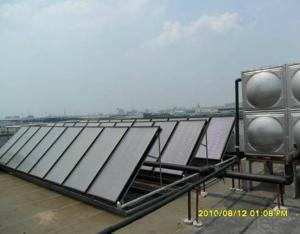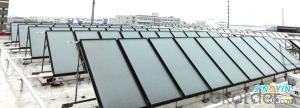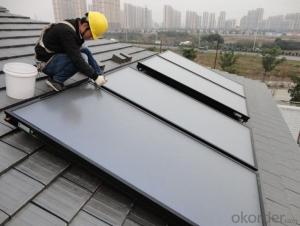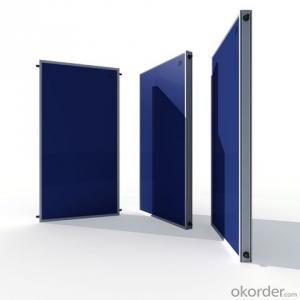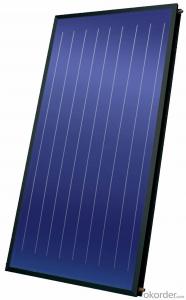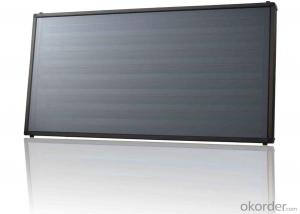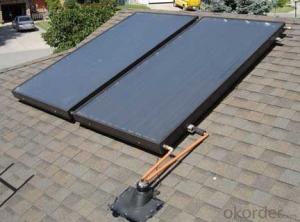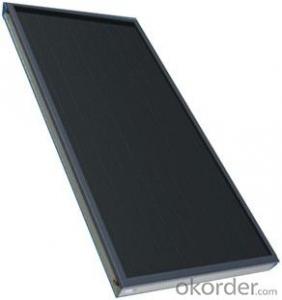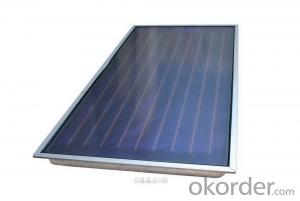Flat Plate Solar Collectors Solar Energy
- Loading Port:
- Shanghai
- Payment Terms:
- TT OR LC
- Min Order Qty:
- 50 pc
- Supply Capability:
- 100000 pc/month
OKorder Service Pledge
OKorder Financial Service
You Might Also Like
Flat Plate Solar Collectors Solar Energy
The flat plate solar collectors is a kind of solar energy into heat energy, the heat generated can be used in everyday life hot water, heating, heating and industrial applications of low temperature hot water. Flat-plate collector is better than glass vacuum tube solar products in structure, strength and performance, its heat production performance, service life and structural strength considerably with building materials, is currently the world's solar thermal utilization products and building integrated fusion best , so the use of flat plate solar collectors is tantamount to the best choice.
The following is solar collectors’ advantages:
1) S-type tube flat plate solar collector, have gotten the line patent in China. Besides, we are Famous factory to produce S-type tube flat plate solar collector, no any welding on the tube, no any leakage.
2) Laser welding between whole absorber panel and copper tube, high strength thicken heavy duty aluminum frame, much better than some technology of ultrasonic welding or heat-conducting glue in some factories.
3) The instant heat efficiency of the collector can up to 81.1%, much higher than the 72% standard, very rare in China.
4) Germany imported high efficient selective blue titanium coating. Use best copper tubes in Domestic. The copper brand is Hai liang.
5) Special low-iron tempered glass with transmittance more than 92%.
6) Mechanical load, freeze resistance, rain penetration, exposure, hail impact, external and internal shock tested etc.
7) Long lifetime, large absorber area and good warm keeping, European, North America specially designed.
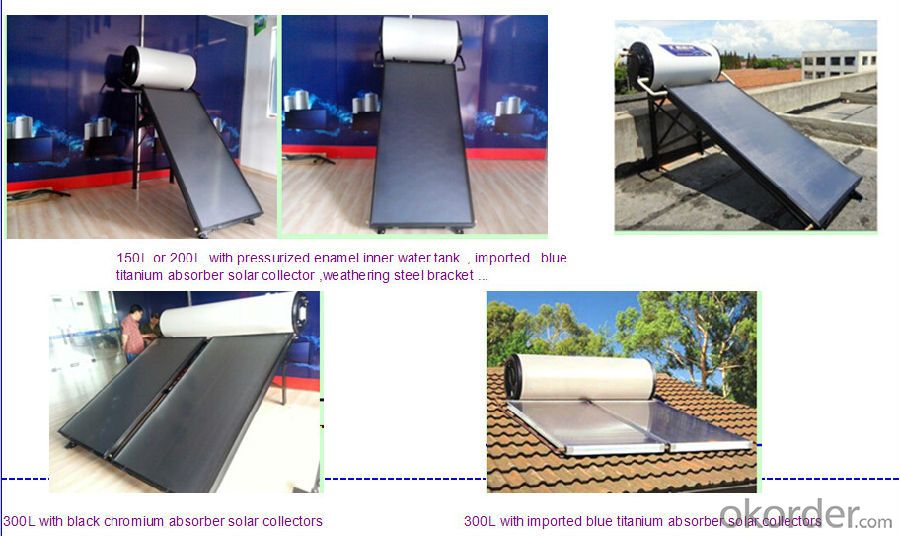
Solar wather heater components:

Flat Plate Solar Collectors installation:
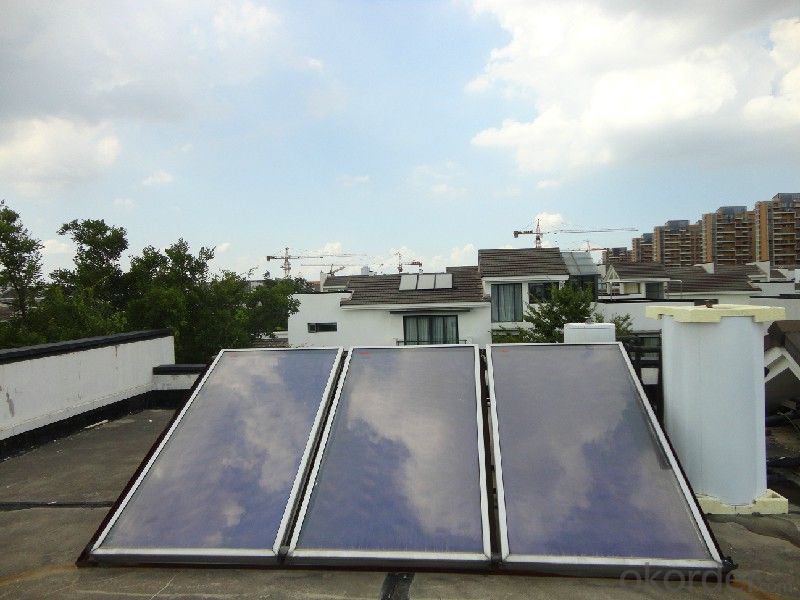
- Q:Can solar collectors be used for heating bus stations?
- Yes, solar collectors can be used for heating bus stations. Solar thermal collectors can capture and convert sunlight into heat energy, which can then be used to warm up the air or water in the bus station. This renewable energy source can provide a sustainable and cost-effective solution for heating bus stations, reducing the reliance on traditional heating systems and minimizing environmental impact.
- Q:Can solar collectors be used in climate change mitigation efforts?
- Yes, solar collectors can certainly be used in climate change mitigation efforts. By harnessing the sun's energy, solar collectors can generate clean and renewable electricity, reducing the reliance on fossil fuels. This helps to reduce greenhouse gas emissions, a major contributor to climate change. Additionally, solar collectors can be integrated into various sectors, such as residential, commercial, and industrial, making them a versatile and effective tool in mitigating climate change.
- Q:What is the ideal location for installing solar collectors?
- The ideal location for installing solar collectors is in areas with abundant sunlight and minimal shade, such as rooftops, open fields, or desert regions.
- Q:Can solar collectors be used in food processing plants?
- Solar collectors, or solar thermal systems, have the capability to be employed within food processing plants. These systems have the ability to collect sunlight and convert it into thermal energy, which can then be utilized to heat water, air, or other fluids for various industrial processes, including food processing. Within food processing plants, solar collectors can be effectively utilized to generate hot water for equipment cleaning, equipment sanitization, pasteurization, and sterilization purposes. Solar thermal systems can achieve the high temperatures required for these processes, thus reducing the dependence on traditional fossil fuel-based heating methods. Furthermore, solar collectors can be seamlessly integrated with food drying systems. Solar drying, a sustainable and cost-effective method of preserving food by reducing moisture content, can be achieved by utilizing the sun's energy to generate heat for the drying operations. This not only reduces energy costs but also minimizes the environmental impact. Nevertheless, it is important to consider various factors, such as sunlight availability, installation space, and specific energy requirements of the plant, when determining the feasibility of implementing solar collectors in food processing plants. However, with advancements in solar technology and the increasing emphasis on sustainability, solar collectors are becoming an appealing option for food processing plants seeking to decrease their carbon footprint and energy consumption.
- Q:Can solar collectors be used in industrial facilities?
- Yes, solar collectors can be used in industrial facilities. Solar collectors can efficiently harness solar energy and convert it into electricity or heat, which can be utilized in various industrial processes such as heating water, powering equipment, or providing space heating and cooling. Using solar collectors in industrial facilities can help reduce reliance on traditional energy sources, lower operating costs, and contribute to a more sustainable and environmentally friendly operation.
- Q:Can solar collectors be used for industrial process heating?
- Yes, solar collectors can be used for industrial process heating. Solar thermal systems can provide heat for various industrial processes such as drying, sterilization, chemical reactions, and water heating. Industrial-scale solar collectors can capture and concentrate sunlight to generate high temperatures suitable for industrial applications, reducing the reliance on fossil fuels and minimizing greenhouse gas emissions.
- Q:How do solar collectors compare to other renewable energy sources?
- Solar collectors have several advantages over other renewable energy sources. Firstly, solar energy is abundant and freely available, unlike wind or hydroelectric power which depend on specific geographic conditions. Additionally, solar collectors have a smaller environmental footprint compared to sources like biomass or geothermal energy. Solar collectors are also highly scalable and can be easily installed on rooftops or in large solar farms, making them accessible to both individuals and utility-scale projects. Lastly, solar energy is reliable and can be stored for later use, providing a consistent and uninterrupted power supply. Overall, solar collectors offer a versatile and sustainable solution for meeting our energy needs.
- Q:Can solar collectors be used in combination with solar tracking systems?
- Yes, solar collectors can be used in combination with solar tracking systems. Solar collectors are designed to capture and convert sunlight into usable energy, while solar tracking systems are used to maximize the amount of sunlight received by adjusting the position of the solar panels or collectors throughout the day. By combining these two technologies, the efficiency and output of a solar energy system can be significantly increased. Solar tracking systems work by following the movement of the sun and adjusting the angle and orientation of the solar collectors accordingly. This allows the collectors to capture sunlight at its optimal angle, maximizing the amount of energy that can be generated. The ability to track the sun throughout the day ensures that the solar collectors are always positioned to receive the maximum amount of sunlight available. In combination with solar tracking systems, solar collectors can enhance the overall performance of a solar energy system. They can be used in various applications, such as solar thermal collectors for heating water or air, or photovoltaic (PV) panels for generating electricity. By utilizing both solar collectors and solar tracking systems, the energy output can be increased, making the system more efficient and cost-effective. However, it is important to note that the implementation of solar tracking systems may come with additional costs and maintenance requirements. The moving parts and mechanisms involved in tracking the sun's movement need to be carefully maintained to ensure proper functioning. Additionally, the increased efficiency offered by solar tracking systems may not always justify the additional investment, especially in regions with high solar irradiance throughout the year. In conclusion, solar collectors can indeed be used in combination with solar tracking systems to maximize the efficiency and energy output of a solar energy system. However, the decision to incorporate solar tracking should be carefully evaluated based on the specific needs, location, and cost-effectiveness of the project.
- Q:What is the maintenance cost for solar collectors?
- The maintenance cost for solar collectors can vary depending on the type and size of the system, as well as the specific components used. Generally, the maintenance cost for solar collectors is relatively low compared to other forms of energy generation. One of the main maintenance tasks for solar collectors is cleaning the panels to ensure optimal efficiency. This can be done using water and a soft cloth or sponge. In some cases, if the panels are installed at an angle, rainwater may be sufficient to keep them clean. Regular inspection of the system is also important to identify any issues or damage that may require repairs. This includes checking for loose connections, damaged wiring, or any signs of wear and tear. It is recommended to have a professional technician perform these inspections to ensure safety and proper functioning of the system. In terms of costs, routine maintenance for solar collectors typically involves minimal expenses. Cleaning supplies, such as water and cleaning agents, may be required, but these are generally low-cost items. If any repairs or replacements are needed, such as fixing a broken panel or replacing a faulty component, the cost will depend on the specific issue and the extent of the repair. Overall, while there are some maintenance tasks and potential costs associated with solar collectors, they are generally minimal compared to the long-term benefits and savings provided by solar energy.
- Q:Can solar collectors be used in areas with limited access to quality control mechanisms?
- Yes, solar collectors can be used in areas with limited access to quality control mechanisms. Solar collectors are relatively simple and durable devices that require minimal maintenance. They can be designed and manufactured to withstand harsh environmental conditions and operate efficiently without the need for frequent monitoring or quality control mechanisms. Additionally, solar energy is a clean and renewable source of power, making solar collectors a viable solution for areas with limited access to reliable electricity grids or quality control infrastructure.
1. Manufacturer Overview |
|
|---|---|
| Location | |
| Year Established | |
| Annual Output Value | |
| Main Markets | |
| Company Certifications | |
2. Manufacturer Certificates |
|
|---|---|
| a) Certification Name | |
| Range | |
| Reference | |
| Validity Period | |
3. Manufacturer Capability |
|
|---|---|
| a)Trade Capacity | |
| Nearest Port | |
| Export Percentage | |
| No.of Employees in Trade Department | |
| Language Spoken: | |
| b)Factory Information | |
| Factory Size: | |
| No. of Production Lines | |
| Contract Manufacturing | |
| Product Price Range | |
Send your message to us
Flat Plate Solar Collectors Solar Energy
- Loading Port:
- Shanghai
- Payment Terms:
- TT OR LC
- Min Order Qty:
- 50 pc
- Supply Capability:
- 100000 pc/month
OKorder Service Pledge
OKorder Financial Service
Similar products
New products
Hot products
Hot Searches
Related keywords

